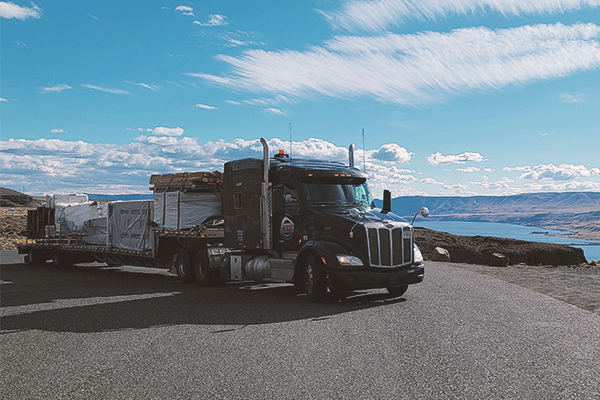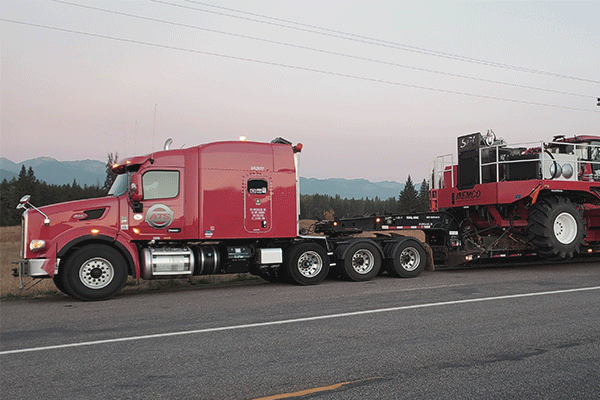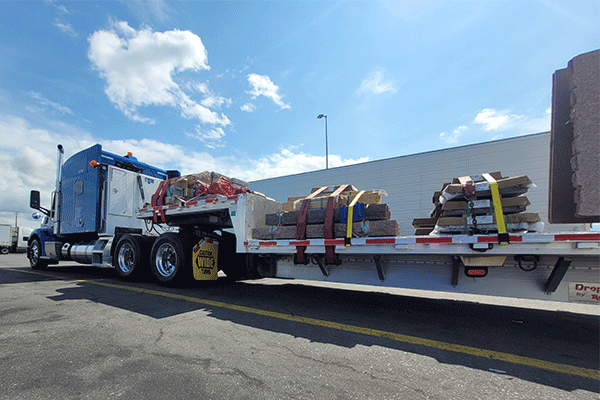Here we are; in the early days of 2022. Following a year in which the transportation industry was tumultuous at best and seemingly impossible to navigate at worst, it’s understandable if you’ve been left feeling fed up and depleted. But you’re not alone.
Every shipper— from California to Maine — saw their bottom lines bear the impact of rate instability over the past 12 months. And you know what? Unfortunately, some of this will likely continue into 2022. The year-over-year comps might look better, but the overall cost level may not.
The main factors, responsible for driving up rates and making it more difficult to secure reliable truck capacity in 2021, haven’t been solved for and additional issues are emerging.
For this reason, it’s important that you and your company enter 2022’s transportation marketplace with the right understandings and expectations.
Following more than 65 years in the transportation industry, here at Anderson Trucking Service (ATS), we’ve learned that education and planning often equate to adaptation and success.
This article is written to help you do just that.
Whether your company moves dry van commodities, refrigerated items or open-deck freight using flatbed and step-deck trailers, below we’ll outline what you can expect to experience — on a relatively macro scale – in 2022.
Below, we’ll cover:
- How demand for transportation services will be influenced in 2022.
- How the supply of transportation services will be influenced in 2022.
- How the cost of providing transportation services will change in 2022?
- How each of these changes will impact the price you pay.
- What you should do to plan this year.
At its conclusion, we hope this article leaves you feeling more confident in your ability to make crucial freight-movement decisions in a year that promises to be interesting, to say the least.
UPDATE: Check Out Paul's Transportation-Industry Market Update For 2023 Here >
4 Indicators Used to Gauge the Transportation Industry’s Health
Let’s begin this discussion by outlining the high-level indicators used by industry professionals to gauge and predict the current and future conditions of the transportation world.
Through quantitative assessment and historical analysis, we can estimate how trends across trucking-adjacent industries and the larger world will impact this industry going forward.
These predictions, however, are simply that and nothing uncovered in this way is guaranteed to occur. That said, the four major indicators that together do an apt job in helping us gauge the health of this industry, are:
- The demand for transportation services.
- The supply of transportation services.
- The cost of providing transportation services.
- The cost of procuring transportation services.
Throughout 2021, these four indicators were hit hard due, in no small part, to the continued battle against Coronavirus. Let’s talk, briefly, about how they changed.
Demand:
As individual spending patterns shifted away from experience-based purchases (travel, concerts, etc.) and toward the acquisition of consumer goods, demand for truck and trailer space surged in 2021.
Supply:
The supply of truck drivers across the United States and the world didn’t recover from 2020’s national Coronavirus shutdown — which prevented driver schools from training a steady supply of new drivers into the workforce and saw the implementation of the drug and alcohol clearinghouse (long-term is good for the transportation industry but short-term had a negative impact).
The Cost of Providing Transportation Services:
Owning a fleet of trucks and trailers and employing the drivers that operate them was more expensive in 2021 than in years past; truck driver salaries increased as trucking companies strove to retain them, fuel costs rose, semi-tractor maintenance costs increased substantially and insurance premiums went through the roof.
The Price of Securing Transportation Services:
For shippers, 2021 was particularly hard on their bottom lines. An inability for transportation companies and freight brokers to meet demand, coupled with increased hard costs, drove spot prices to all-time highs. And, contracted freight agreements — which would do the job in the past — couldn’t secure the truck capacity shippers needed in 2021.
Related: A Synopsis of The Transportation Industry in 2021 [Key Changes and Takeaways]
Now that you have an understanding of the core indicators the industry uses to evaluate the transportation industry and have a bit of insight into how these changed in 2021, let’s look at the year ahead.
How Will The Demand For Transportation Services Be Influenced In 2022?
The demand for transportation services has always been influenced by the way people spend their money. A collective shift in spending patterns changes the way businesses operate and their supply chains function.
Beginning in 2020, and carrying through to 2021, rising consumerism took a toll on the transportation industry.
As people sat at home isolated behind their desktop and mobile devices — spending more dollars on consumable commodities — carriers across the world struggled mightily to keep up.

But who can blame them?
In 2021, the United States’ gross domestic product (GDP) — commonly used to provide insights into the overall economic health and size based on the production and growth rate of a country— rose an estimated 5 percent.
When a nation’s GDP rises — signifying an uptick in economic production — the overall demand for, and distribution of, money accompanies it as citizens spend their hard-earned dollars on the fruits of this production.
With this in mind, it stands to reason that this pattern of consumer spending — and the increased stress it puts on the transportation world — would continue into 2022 when GDP is expected to rise by 4 percent.
While we do expect demand for trucks to remain steady in the new year, we don’t think consumer spending will be to blame.
You see, analyses presented in the latter half of 2021 suggest that monetary inflation is currently on the rise with significant increases to the United States’ consumer price index on the horizon.
As such, it’s expected that people may change their spending habits due to inflation and could hold more cash, invest their income and/or dedicate dollars to things besides tangible goods. In turn, the demand for consumer-based truck capacity may actually decrease in 2022.
That said, the distribution of outbound freight shipments that accompanied 2021 has left business inventories low across the board.
Add in the ongoing congestion challenges occupying international ports — which make it difficult for companies to replenish their warehouses — and we’re left with one glaring reality: Eventually, something has to give and when it does the transportation industry will be tested once again.
As manufacturers and businesses try to get back on track, at minimum, 2022 promises to be a year of inventory replenishment — thus maintaining or increasing the transportations industry’s workload once more.
How Will The Supply of Transportation Services Be Influenced In 2022?
Up to this point, an ongoing national driver shortage has stunted the supply of trucking solutions across our nation; we just don’t have enough properly trained truckers to meet demand.
Although this shortage is expected to continue into 2022, an equipment shortage is also on the ascent.
According to industry experts, a minimum of 230,000 new semi-trucks must be introduced to the United States trucking industry every year in order to maintain an adequate age of fleet across companies.
With younger fleets, trucking companies can keep their trucks running efficiently and supply capacity without worrying — as much— about truck breakdowns and maintenance issues.
Over the past year though, supply chain disruptions, labor shortages and a lack of available parts have made it impossible for truck manufacturers to produce the replacement level minimum asked of them.
Without the ability to acquire new vehicles, transportation companies can’t properly maintain the age of their fleets. And, as the average age of each fleet grows, so too does the cost of maintaining them and the rate at which trucks break down.
As such, the supply of transportation solutions available to move your freight might take a hit next year as trucking companies struggle to keep truck drivers behind the wheel and the trucks they operate in good health.

How Will The Cost of Supply Transportation Services Change in 2022?
Four key costs associated with providing transportation services are truck driver salaries, paying for fuel, purchasing insurance and purchasing/maintaining trucks.
Collectively, these costs play a role in the final rates shippers pay to utilize transportation services.
In 2021, each of these expenses increased and this pattern is likely to continue into the new year, here’s how:
How Will Truck Driver Salaries Change In 2022?
Over the past few years, truck driver salaries have been on a steady incline as trucking companies try to retain the quality drivers in their fleets. In 2022, a year in which the impact of the pandemic will still be felt and new drivers will be hard to come by, truck driver salaries are likely to continue to rise.
This is especially true as all-time-high spot rates motivate many drivers to make their own way as owner/operators and industries like construction offer them another career path — with similar earning opportunities — to opt for.
How Will Fuel Prices Change in 2022?
Filling the entirety of a semi-truck’s fuel tank got more expensive as 2021 rumbled along with prices peaking across our nation in November. As we inch closer to 2022, it’s difficult to see fuel prices subsiding — at least in any substantial way.
Related: An Explanation of How Rising Fuel Prices Affect Transportation (+ 3 Budgeting Tips)
How Will The Cost of Equipment Maintenance and Renewal Change?
As previously stated, supply chain disruptions and labor shortages have made it more difficult for vehicle manufacturers to produce new trucks. In turn, recent history has left trucking companies with more issues securing replacements for aging vehicles and the parts necessary for maintaining them.
Transportation companies will need to allocate more of their dollars toward vehicle maintenance and renewal in 2022 than they have in the past.
Rising maintenance prices could motivate many of the drivers that left their trucking companies in 2021 to return to larger fleets where these costs aren’t theirs to shoulder alone.
How Will Insurance Costs Change in 2022?
Recently, nuclear verdicts — court-awarded rulings that are exceptionally high — have become increasingly common in the transportation industry. For this reason, the insurance premiums paid by transportation companies have increased substantially over the past few years, creating a pattern of insurance-cost inflation that will continue in 2022.
How Will Transportation Rates Change in 2022?
Together, market demand for transportation services, the total amount of solutions transportation companies can supply, and the costs carriers incur in order to do so, impact the final freight rates shippers pay.
In 2022, a year that promises a hold-over in heightened demand, lower-than-usual supply levels and increased costs across the board, freight rates will rise.
Spot prices, which indicate the going rate for transportation services, increased substantially over the past 12 months. And, even though they’ve seen a slight decrease recently, it’s likely that they’ll continue to be elevated in 2022.
Additionally, this could make it more difficult to secure capacity at previously-contracted freight rates.

Needless to say, in order to maximize your transportation budget, you’ll want to be as prepared as possible in 2022. Let’s talk about what you can do.
How Should You Plan For Freight Transportation In 2022?
When it comes to the on-time and cost-effective transportation of your freight in the year to come, flexibility will be your best friend.
As the world around you continues to battle against Coronavirus, supply chain congestion issues, anything you can do to make your freight easier on carriers will be beneficial in the long run.
Flexibility in equipment type and appointment times will help you do just that.
1. Flexibility on Equipment Types
The transportation world is full of unique trailer types and services designed to solve various problems for shippers with goods to move. That said, many of these trailers are interchangeable, making it easier for shippers with an open mind to find a solution for their load.
In 2022, give your transportation provider some credit. Trust them when they tell you that a 53-foot step-deck trailer would meet your requirements just as well as a flatbed, or that hot-shotting your load is your best option.
Opening your business up to a variety of options in order to increase your pool of potential solutions — no matter how out-of-the-box they may seem — will help you secure a truck at competitive price points — even if 2022 makes it more difficult.
2. Flexibility on Appointment Times
Rigid appointment times for pickup and deliveries will be hard for truckers to meet in 2022, especially on short notice. And, when a shipment makes it more challenging for drivers to get the most from their hours of service, finding a solution for it is tough — even in the best of times.
Work with your providers to arrange pick-up and drop appointments that match their capabilities and desires.
Doing so will help your provider slip your freight onto the over-crowded schedules of local and area drivers without having to pay through the nose to do so.
Finding a Truck Faster in 2022
Now that you have a comprehensive understanding of how the transportation industry is slated to change in 2022, and have a couple of tactics for avoiding the potential price-hikes of the new year, let’s take this one step further.
More often than not, your ability to find a solution for your shipment is tied to how appealing it is in the eyes of area drivers.
- Will this load help me stick to my schedules and maximize my on-duty service hours?
- Will I be able to comfortably haul this load given its specification and timelines?
- Is it clear that this shipment’s needs align with my capabilities?
These, and questions like these, travel through the minds of drivers each time they decide whether to service a shipment. As such, in the hopes of securing capacity when and where you need it in 2022, you’ll want to make your freight as appealing as possible.
To help you do so, we’ve put together this 12-part guide to finding a truck faster, download it today and make sure that when it’s time for the rubber to meet the road you’ll have no trouble finding a truck in 2022.
Finally, ATS will be here throughout 2022 to help you in any way you need. Feel free to reach out to us at any time with questions, inquiries and concerns. One of our transportation experts will be happy to assist you in 2022 and for years to come.





